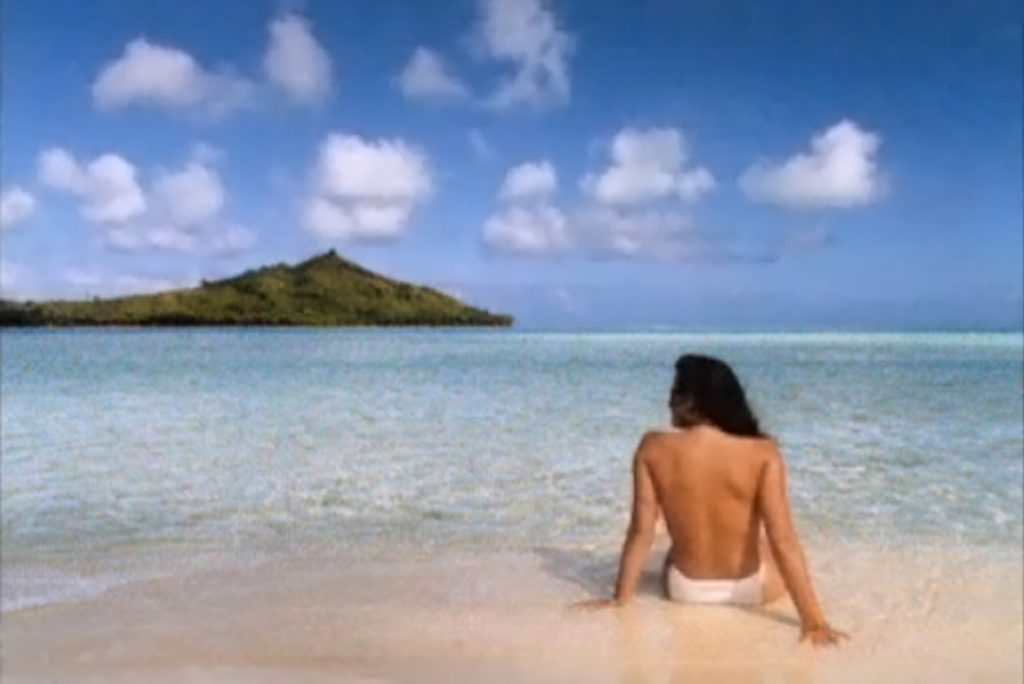
<!– Jennifer in Palestine –>
<title>Jennifer in Photoshop, Constant Dullaart 2014, Courtesy Hugo and Carla Brown collection ‘Cobra to Contemporary’ </title>
<!– Jennifer in Post Scriptum –>
<!–
Berlin /Paris /London 2013-2014
Dear Jennifer,
Sometime in 1988, you were sitting on a beach in Bora Bora, looking at To’opua island, enjoying a holiday with a very serious boyfriend. The serious boyfriend, John, took a photograph of you sitting on the beach, not wearing your bikini top. John later became your husband and father to your children Sarah, Lisa, Alex and Jane.
This photograph of a beautiful moment in your personal history has also become a part of my history, and that of many other people; it has even shaped our outlooks on the world at large. John’s image of you became the first photograph to be publicly altered by the most influential image manipulation program ever. Of course, this is why I know the names of your children, and this is also why I know about the cool things you do trying to get a ‘.green’ top level domain name to promote environmental sustainability. (Although, personally, I believe that the importance of the domain name has been reduced to a nostalgic, poetic value).
I still wonder if you felt the world change there on that beach. The fact that reality would be more moldable, that normal people could change their history, brighten up their past, and put twirl effects on their faces? That holiday image became the first photograph publicly manipulated in Photoshop, and your intimate beach moment became the reality for several potential clients to play with. Two Jennifers, no Jennifer, less clouds, etc. In essence, it was the very first photoshop meme—but now the image is nowhere to be found online.
Did John ask you if he could use this particular image? Did you enjoy seeing yourself on the screen as much as he did? Did you think you would be the muse that would inspire so much contemporary image making? Did you ever print out the image yourself? Would you be willing to share it with me, and so, the other people for whom it took on such an unexpected significance? Shouldn’t the Smithsonian have the negative of that image, not to mention digital backups of its endless variations?
All these questions have made me decide to redistribute the image ‘jennifer in paradise’ as well as I can, somewhat as an artist, somewhat as a digital archeologist, restoring what few traces of it I could find. Restoring the image from what was available to everyone, in the somewhat ‘public space’ of the internet. It was sad to realize this blurry screen grab was the closest I could get to the image, but beautiful at the same time. How often do you find an important image that is not online in several different sizes already?
This beautiful artifact of software development has become art work in this way, in which you, or at least your depiction, play a central part in this body of work that has become so dear to me. A faint, blurry, pixelated focal point. A work that celebrates the time that you were young, and the world was young, as it still naïvely believed in the authenticity of the photograph.
Sometimes, when I am anxious about the future of our surveilled, computer-mediated world, when I worry about cultural imperialism and the politics behind software design, I imagine myself traveling back in time. just like the Terminator, to that important moment in technological world history, there on the beach in Bora Bora. And just sit there with you, watching the tide roll away.
Sincerely, Constant Dullaart
P.S. Since I first wrote this letter, your husband was contacted by a journalist from the Wall Street Journal to respond to this art work. He has generously given more details on the story behind the photograph, like the fact that he asked to marry you the very next day, and scanning the image on a Sharp JX-450 scanner with the help of his friend Jim Batson. He also told me you could not recall receiving any message from me. Although I have contacted you on your twitter account, and on your work address, but perhaps these messages have eluded you. Currently, if I Google your name, the first result, is the first rendition of this letter published on Rhizome.org. I hope some version of this letter will reach you soon, and you will be able to reply. In the mean time I have taken the restored depiction of you, and applied 72 filters available in Photoshop Creative Suite 6 to the image.
–>
In 2013, Constant Dullaart started a landmark project in digital archeology. The artist set out to find and revive the first image used as demonstration for the image editing programme Photoshop. Shot in 1988 by Photoshop’s co-creator John Knoll, the image shows Knoll’s then-girlfriend reclining on a beach in Bora Bora. Minced through hundreds of filters, Jennifer’s picture had disappeared from the web until Dullaart painstakingly brought it back to life, pixel by pixel. His Jennifer in Paradise series (2013-ongoing) presents the restored image as lenticular prints materialising a range of standard Photoshop filters. Here, he writes to Jennifer about her passing role in a key moment of the relationship between photography and notions of truth and authenticity.
Image: Constant Dullaart, Jennifer_in_Paradise, 2013. Courtesy the artist and Carroll / Fletcher, London